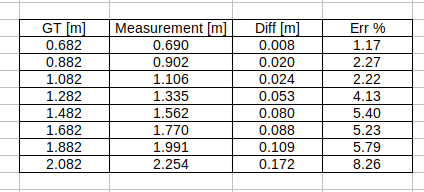Hello,
I'm performing a metrological assessment of a brand new OAK-D-PRO-FF device. This is done by moving a vertical target by means of a translating sled.
I wrote my own code following the tutorial instructions and I double checked the results with those of the examples provided in the Luxonis' repo. Results are quite consistent, mine are a bit better just because I'm using proper filters.
The distance is assessed either averaging or calculating the median value of a 15px side square part of a flat plane of which points are equidistant from the camera. RGB alignment doesn't significantly modify the outcome. The projector is on.
The results that I get are very bad and also very different from all the experiences that I found in the Internet. Please find a summary in the attached file: z difference is higher than 8% at 2 m. Subpixel analysis is active and, if I increase the fractional bits, I get a "less quantized" cloud but equally inaccurate. Using 400_P or 720_P (with decimation 2) resolutions doesn't change the result either.
I don't think that I'm making particular mistakes (if needed I can also attach my code), therefore I'm wondering whether there might be some issues with calibration. Nonetheless, I'd like to get a feedback before recalibrating the system, which is supposed to provide good results even with the factory calibration.
I performed the same procedure (using the same analysis code) with an Intel Realsense D435 and I got errors below 2%, as expected.
Can you please help me?
Thanks
Alessandro
